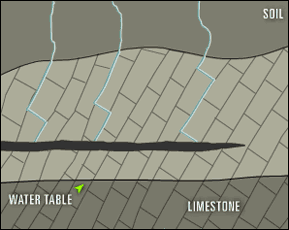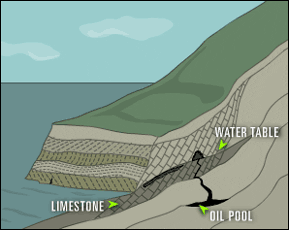|
 Cave-Making Agent: Rainwater
Cave-Making Agent: Rainwater

|
Limestone caves, which are formed primarily by rainwater and
snowmelt, are by far the most numerous of all cave types.
Limestone formations were created millions of years ago, often
in shallow seas, largely from the accumulated remains of
marine animals such as corals. This type of sedimentary rock
forms large, solid, rectangular blocks.
|

|

|

|
|
Rainwater and snowmelt seeping into the ground absorb large
amounts of carbon dioxide, which is a product of decaying
organic matter.
The water and carbon dioxide together form carbonic acid.
|

|

|

|
|
This carbonic acid continues to seep into the soil and through
the limestone until it reaches the water table, which is the
upper limit at which ground is saturated with water.
The acid moves fast enough through the limestone that it does
not create channels as it makes its way to the water table.
|

|

|

|
|
The carbonic acid eats away at the limestone at a level
directly below the water table, eventually forming channels.
The larger a channel becomes, the more water it holds and the
faster the limestone dissolves.
These channels may form along the water table or they may
extend down below the table along fissures within the
limestone.
|

|

|

|
|
The cave typically forms over a period of a few million years,
slowly increasing in size.
Later, if the water table lowers, the enlarging of the cave
stops. It is at this point that dagger-like stalactites and
stalagmites sometimes begin to form as mineral-laden water
drips through the cave's ceiling.
|

|

|

|
|
If it's moving fast enough within the cave, water can also
carve a larger, deeper path through the rock by corrasion
(erosion by abrasion), just as a river carves through rock to
create a canyon.
Moving water can also form caves within glaciers and sandstone
caves at the base of cliffs.
Choose another way that caves can form.
|

|

|

|
|
|

